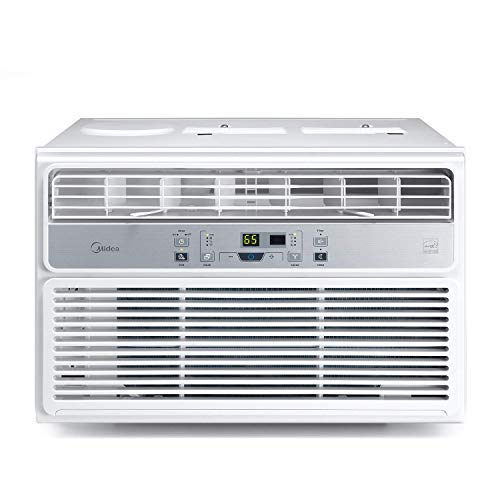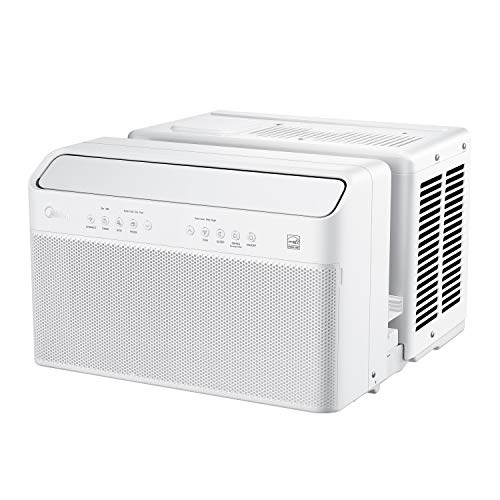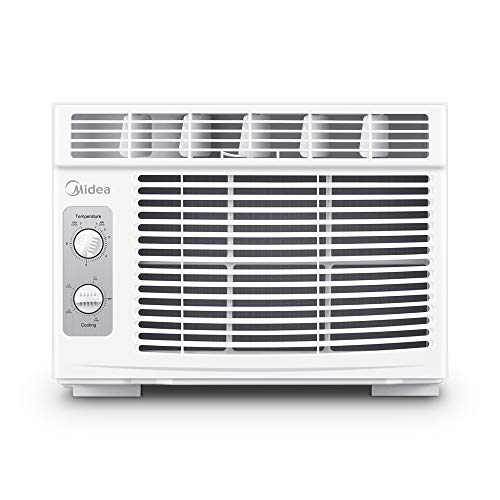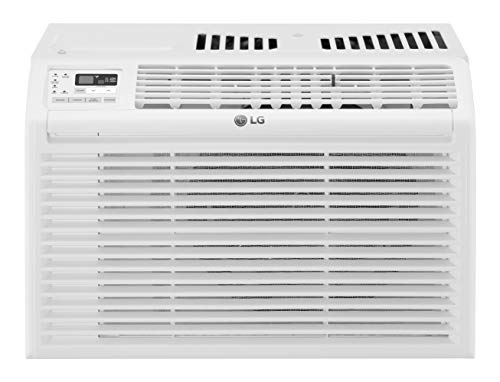Window AC units are substantially more convenient than their wall-mounted counterparts in the sense that they require less in terms of setup, and you won’t need to pierce your walls with nails and hardware to keep them in place.
If you’re searching for the best window AC to warm (or cool) your home, you’ve certainly come to the right place. Central heating is great to have during winter times, but we’re just a couple of months away from summer, and that’s the worst possible time to be worrying about installing an air conditioner. If you find this to be a hassle to install, consider a portable air conditioner then!
These beautiful gadgets can also help warm your home, so if you’re like me and are not too keen on central heating, you’d swat two flies with a single hit. Without any further ado, let’s dive into the best Window AC unit reviews:
Best Windows AC Conditioners Listed
1. Midea EasyCool Window Air Conditioner
Highlighted features:
- Dimensions: 16.02 inches by 18.54 inches bu 13.39 inches
- Weight: 53.9 pounds
- Voltage: 110 volts
- Wattage: 667 watts
- Three fan speeds
- Three cooling modes
- Built-in timer
- Filter sensor
Quick overview:
I wanted to start off the review with a well-rounded AC unit, so let’s begin with MIdea’s EasyCool Window Air Conditioner. Essentially, this is a remarkably strong, durable, and feature-packed model that offers reliable, consistent performance at a decently affordable price tag.
It packs 667 watts and 8,000 BTUs, which should be more than enough power to cover a 350 square-foot area. As a matter of fact, it can easily lower the temperature of entire floors, unless you are living in an actual mansion.
Now, I liked the plethora of selectable modes that Midea’s EasyCool AC offers; first and foremost, even if you’re unsure about which mode to use, not touching anything is the best course of option – this means that the AC will remain on ‘auto’ mode that will adjust its temperature based on how hot or cold the room is.
Dimensions-wise, the EasyCool measures 16.02 inches by 18.54 inches by 13.40 inches while weighing approximately 53.9 pounds. It’s certainly bulky and relatively heavy, but it’s nothing that you should really be concerned about.
There are three fan-speed modes (including the fourth ‘automatic’ mode), the ‘sleep’ mode, and economy mode. Basically, you’ll be able to easily adjust the temperature levels, cut a portion of your electricity bill with the ‘Eco’ mode, or program the built-in timer to keep the area breezy while you’re not home.
[i2pc show_title=”true” title=”Pros & Cons” show_button=”true” pros_title=”Pros” cons_title=”Cons” button_icon=”icon icon-cart-4″ link_text=”Check The Price Here” link=”https://amzn.to/3ClgiK2″ ][i2pros]Dozens of selectable modes
Convenient built-in timer
Three fan speeds
8,000 BTUs
Built to last[/i2pros][i2cons]Bulky and heavy
Moderately pricey[/i2cons][/i2pc]
2. Midea U Inverter Window Air Conditioner
Highlighted features:
- Dimensions: 21.97 inches by 19.17 inches by 13.47 inches
- Weight: 69.9 pounds
- Voltage: 115 volts
- Wattage: 890 watts
- App-based operation
- Wi-Fi connectivity
- Four selectable modes
- Three fan speeds
- Built-in timer
Quick overview:
Next up is another AC unit from Midea; the U Inverter AC is remarkably more flexible than most window air conditioners due to the fact that it allows you to open the window it is mounted to at any time without interfering with the AC’s performance.
As far as dimensions are of concern, Midea’s U Inverter Window AC measures 21.97 inches by 19.17 inches by 13.46 inches; it weighs 69.9 pounds, which is considerably higher than average. However, I’ve found that this is its only drawback aside from the hefty price tag.
Another thing that separates Midea’s U Inverter from most powerhouse AC units is the fact that it boasts a nearly soundless method of operation. Namely, most air conditioner models with such a high BTU rating are typically pretty noisy, while U Inverter keeps the sound emissions below 42 decibels.
Speaking of BTU, with 10,000 British thermal-units you can rest assured that you’ll be able to cool even the largest rooms of your house, regardless of how huge it may be.
The smart control allows you to use all of its features directly from your phone, plus it’s compatible with your home’s Wi-Fi network; in my humble opinion, this is as far as convenience is supposed to lead you, although its mechanical settings work perfectly fine too.
Last, but not least, this window AC unit is obviously built to withstand decades of use and abuse. It’s as strong as they come, and it doesn’t require much (or too frequent) maintenance. Overall, I would say Midea’s U Inverter Window AC is pricey, but well worth the buck.
It’s one of the most durable and best-performing boutique AC units I’ve come across in my search, and I would warmly recommend it to anyone who doesn’t feel dissuaded to invest a bit more cash in quality.
Personally, I think it would be fair to say that it’s one of the best window unit AC models on the market, as well as one of the best window air conditioner models for large rooms.
[i2pc show_title=”true” title=”Pros & Cons” show_button=”true” pros_title=”Pros” cons_title=”Cons” button_icon=”icon icon-cart-4″ link_text=”Check The Price Here” link=”https://amzn.to/3kILBIF” ][i2pros]Smart control features
Whisper-quiet operation
Numerous fan control settings
Quality built-in timer
Sleep & Eco modes
10,000 BTUs[/i2pros][i2cons]Much heavier than average
Very expensive[/i2cons][/i2pc]
3. Midea MAW05M1BWT Window Air Conditioner
Highlighted features:
- Dimensions: 15.98 inches by 13.19 inches by 12.05 inches
- Weight: 39.9 pounds
- Voltage: 110 volts
- Wattage: 450 watts
- Mechanical temperature and cooling settings
- 5,000 BTUs
Quick overview:
The last Midea’s AC on my list is the MAW05M1BWT Window Air Conditioner Unit. Essentially, this AC is fairly cheap, moderately strong, sturdy, and straightforward, so I’d recommend it to people who live in smaller homes and who are on a tight budget.
Basically, it’s the polar opposite of the U Inverter model in nearly all respects – it packs half the BTU, it’s fully mechanical in terms of design, it’s much smaller, and it weighs a portion of the U Inverter AC. Even though its performance is obviously different, it brings a dissimilar set of benefits to the table.
Its dimensions measure 15.98 inches by 13.19 inches by 12.05 inches while it weighs approximately 39.9 pounds. That’s one of the things I liked the most about it – it’s small, not as punishing in terms of storage, and I could even easily move it from place to place whenever I wanted to.
The downside here is that it needs to be assembled when the box arrives; the installation part is typically straightforward, and most people hire professional handymen to complete it, but assembling an AC is what they normally charge extra.
Now, back to the brighter end, this fully mechanical window AC packs seven different temperature settings, two fan speeds, and two cooling speed modes; it’s pretty versatile for an all-analog air conditioner, although it can’t really match the well-roundedness of bigger, more expensive Midea units.
Finally, the main reason why I’m recommending Midea’s MAW05M1BWT is that it offers superior energy efficiency. Namely, if you’re out on the market searching for an AC unit that won’t ramp up your electricity bills sky high, look no further than this model.
[i2pc show_title=”true” title=”Pros & Cons” show_button=”true” pros_title=”Pros” cons_title=”Cons” button_icon=”icon icon-cart-4″ link_text=”Check The Price Here” link=”https://amzn.to/3oBZlGg” ][i2pros]Light and compact
Fairly inexpensive
Decently durable
Perfect for smaller homes and apartments
Quiet method of operation
Numerous temperature and fan settings[/i2pros][i2cons]
Full-analog method of operation
Minor assembly required[/i2cons][/i2pc]
4. LG LW5016 Window Air Conditioner
Highlighted features:
- Dimensions: 19.63 inches by 16.75 inches by 13.69 inches
- Weight: 44.2 pounds
- Voltage: 115 volts
- Wattage: 440 watts
- Sturdy plastic construction
- Mechanical temperature controls
Quick overview:
We’re moving over to LG, which is one of the best window air conditioner brands on the current market. This is the LW5016 – a 5,000 BTU mechanical air conditioner that is arguably the simplest, most straightforward model in the lower tier of the middle price point category.
The size of LG’s LW5016 is pretty much average; its dimensions measure 19.63 inches by 16.75 inches by 13.69 inches while it weighs around 44.2 pounds. Comparing it to other window ACs, I’ve figured it’s about average in these respects.
Generally speaking, it packs enough strength to warm or cool a smaller area (around 150 square-foot large), and it’s easy enough to use that even children can operate it without any hint of problems.
It doesn’t have a remote controller as it is a mechanical AC, so you’ll have to manually set the settings every time you want to use it.
The knobs are fairly big and responsive, which is not something the vast majority of analog ACs can boast about. As far as budget ACs are of concern, I would say that LG’s LW5016 is the best window unit on the current market.
[i2pc show_title=”true” title=”Pros & Cons” show_button=”true” pros_title=”Pros” cons_title=”Cons” button_icon=”icon icon-cart-4″ link_text=”Check The Price Here” link=”https://amzn.to/3oBs9P8″ ][i2pros]Very cheap
Decently light and portable
Remarkably easy to use
Two-way air direction controls
Cool and heating modes[/i2pros][i2cons]Needs to be assemble prior to use
All of its features can only be accessed manually[/i2cons][/i2pc]
5. Frigidaire Energy Star Window-Mounted Compact Air Conditioner
Highlighted features:
- Dimensions: 15.5 inches by 18.5 inches by 13.2 inches
- Weight: 47 pounds
- Voltage: 115 volts
- Wattage: 500 watts
- Eco and Sleep modes
- Integrated timer
- Four fan speeds
- Remote Sensing
Quick overview:
If you live in a slightly bigger apartment and have an air conditioner that doesn’t seem to cool the place efficiently, I would suggest that you should upgrade to Frigidaire’s Energy Star AC.
This is a small, energy-efficient conditioner that packs 6,000 BTU rating, a sturdy plastic construction, and a variety of remotely-operated electric controls. Some of the most notable ones include the built-in timer, remote sensing, four fan speed options, eco mode, sleep, and more.
Frigidaire Energy Star dimensions measure 15.5 inches by 18.5 inches by 13.2 inches while weighing roughly 47 pounds; this AC is shorter and slightly wider than average.
Moreover, it packs a 500-watt motor, but it won’t make your electricity bill skyrocket. In my opinion, this may be the best window AC unit in its price range.
[i2pc show_title=”true” title=”Pros & Cons” show_button=”true” pros_title=”Pros” cons_title=”Cons” button_icon=”icon icon-cart-4″ link_text=”Check The Price Here” link=”https://amzn.to/3chzb63″ ][i2pros]High level of versatility
Decently easy to use
A bit more affordable than most mid-tier Window AC units
Made of durable plastic materials
Compact and easy to install[/i2pros][i2cons]Becomes loud at higher fan-speed modes
The remote does not feature a ‘cool’ button[/i2cons][/i2pc]
6. Tosot Window Air Conditioner
Highlighted features:
- Dimensions: 21 inches by 17.2 inches by 12.8 inches
- Weight: 52.9 pounds
- Voltage: 115 volts
- Wattage: 660 watts
- Automatic cooling mode
- Built-in dehumidifier and timer
- Vertical-swing mode
- Power-outage restart
- Clean-filter alarm
Quick overview:
Tosot’s Window AC is my personal favorite for a plethora of reasons – it’s strong, sturdy, and more importantly, it is packed with a myriad of convenience features, including the vertical-swing mode, a variety of fan speed options, fully automated cooling modes, and more.
The Tosot’s Window Air Conditioner’s dimensions measure 21 inches by 17.2 inches by 12.8 inches while it weighs 52.9 pounds. It’s certainly a bit bulkier and a tad heavier than average, but it’s still pretty compact and easy to handle.
Safety-wise, the AC will not automatically turn on in case of a power outage – it is equipped with a neat little short-circuit switch that protects its most vulnerable features in situations such as these.
Personally, I’ve found the automated modes as remarkably convenient, especially the clean-filter sensor that reminded me whenever I needed to replace them.
[i2pc show_title=”true” title=”Pros & Cons” show_button=”true” pros_title=”Pros” cons_title=”Cons” button_icon=”icon icon-cart-4″ link_text=”Check The Price Here” link=”https://amzn.to/3HrY79i” ][i2pros]Built to withstand decades of use and abuse
Superior level of versatility
Packed with a myriad of convenience features
Terrific for medium and large-sized homes
Short-circuit protection[/i2pros][i2cons]Slightly pricier than average
Heavy[/i2cons][/i2pc]
7. Keystone Window-Mounted Air Conditioner
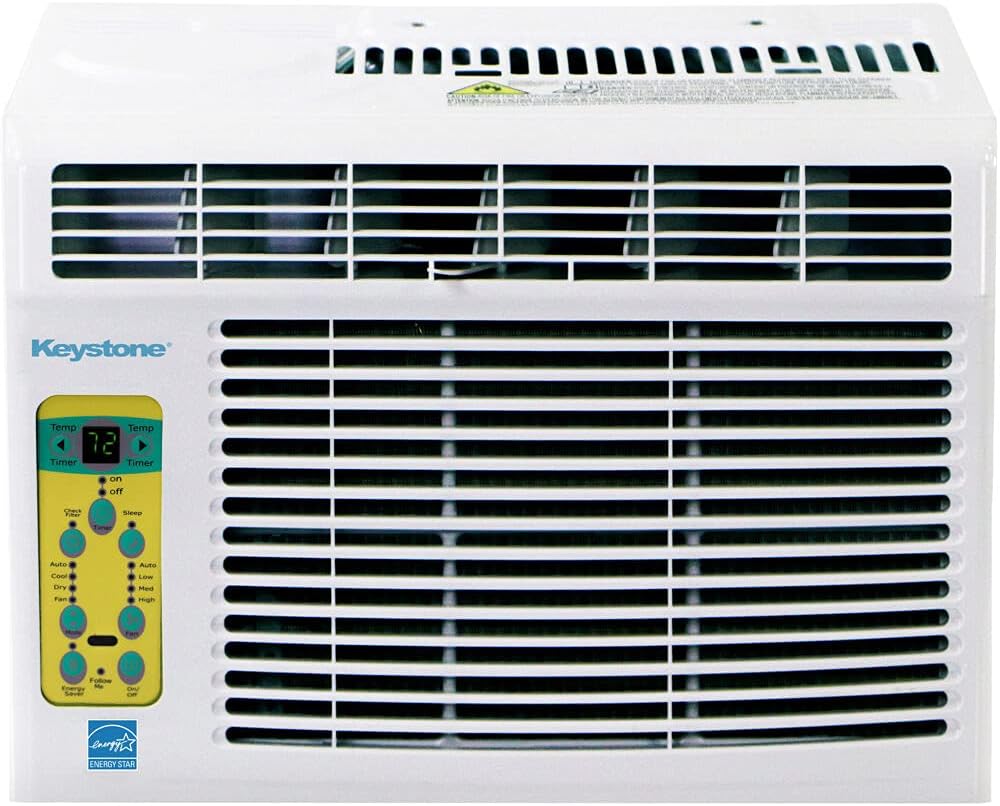
Highlighted features:
- Dimensions: 15.4 inches by 16 inches by 12 inches
- Weight: 40 pounds
- Voltage: 115 volts
- Wattage: 446 watts
- Remote and mechanical features
- 10,000 BTU
- LED display
- Four fan speed settings
- Built-in timer feature
Quick overview:
Let’s wrap things up with Keystone’s window AC – this is my recommended pick for people who live in smaller apartments and homes and who wish to keep their electricity bills down to the bare minimum.
In terms of size, the dimensions of Keystone’s Window-Mounted Air Conditioner are 15.4 inches by 16 inches by 12 inches. It weighs only 40 pounds, making it one of the lightest window AC units on the list.
The Keystone AC is basically a ‘hybrid’ in the sense that it packs both digital (remote) and mechanical (analog) features; it’s outfitted with four working modes and three fan speeds, a timer, manual temperature settings, and directional swing.
As far as I’m concerned, Keystone’s model is the best small window air conditioner on the market, mainly due to its dependability and consistent performance.
[i2pc show_title=”true” title=”Pros & Cons” show_button=”true” pros_title=”Pros” cons_title=”Cons” button_icon=”icon icon-cart-4″ link_text=”Check The Price Here” link=”https://amzn.to/3oQKqZd” ][i2pros]Remarkable value for the money
Decently affordable
Excellent electricity consumption economy
Versatile features and modes
Several fan speed settings[/i2pros][i2cons]Relatively weak
Small display[/i2cons][/i2pc]
What to look for in a Window AC
Quite a bit of technical jargon surrounds air conditioners, window-mounted units included. Things such as BTU ratings, timers, ionizers, filters, and similar specs become valuable only when you start understanding what they can be used for.
I’m sure that not many people are perfectly aware of all the little details regarding how AC units operate, much less what to look for in one, so I intend to help acquaint you with the most important aspects you should keep in mind.
Size & weight
Smaller models are generally lighter, although this is not a definition per se. Weight is a bit more important, as weaker window frames will have a tough time handling a massive, super-heavy air conditioner.
BTU rating
British Thermal-Units represent the strength of an air conditioner – the higher the rating, the stronger the workhorse is. Smaller homes can be cooled off with <5,000 BTU units while larger mansion-like houses may require a 10,000 BTU model.
Manual vs Remote controls
In other words, mechanical versus digital air conditioners. While mechanical units are easier to operate, digital are far more versatile, albeit they are oftentimes more expensive too.
Durability
Most parts of an AC are made of plastic, which is the main reason why durability is such an important factor. Flimsy parts break easily, and the vast majority of AC parts are very difficult (or downright impossible) to repair.
Price
Being the most definitive factor, price is certainly a major issue for most people. That’s the reason I’ve included multiple models from each price point category, so I’m sure you’ll find a model that suits your wallet just fine.
Common features of a wall-mounted air conditioner
Even though various companies manufacture different air conditioners (and supply them with different features), there’s a visible threat that connects all of the models that belong in this category. Some of the most notable Window Air Conditioner features include:
Programmable timer
A convenient feature that allows you to set the exact time when you wish your home to be as cool (or as hot) as you like. It’s integrated with the temperature settings and all of the other features as well; models that pack dehumidifying technologies can also link them with the programmable timer.
Display
A feature exclusive to digital AC units. The display is typically outfitted with manual controls and indicator lights that will tell you which features are currently active.
Filter sensor
This is one of the most convenient features an AC unit can have. It will remind you when you need to replace the filter, taking out all the guesswork behind it.
Frequently asked questions
Most AC units come equipped with a handy manual that is supposed to answer all questions you may have regarding its performance.
However, sometimes a bit of info is left out of the picture, so I’ve took it upon myself to answer some of the most frequently asked questions regarding Window air conditioners:
-
Can a window AC cool a whole house?
In essence, wall-mounted and window-mounted air conditioners are mostly different in terms of design and compactness; two models may look completely different while at the same time their performance could be nearly identical.
The coverage of an AC unit is based on its BTU rating. Strictly speaking, AC units with less than 5,000 BTU could only accommodate smaller homes with a couple of rooms; the larger the place is, the stronger the model you’ll need.
As a rule of thumb, we could take Keystone’s model as the perfect example of a low-performance AC – it packs 5,000 BTU and can accommodate homes up to 150 square-foot large.
On the other end of the spectrum is the Tao Tronics TT-AC001 – it packs 10,000 BTU and is perfect for homes that are up to 460 square-foot large.
-
Do window units make your electric bills go up?
Simply put, any air conditioner will make your electric bills higher, just like any device or gadget that relies on electricity to power up.
Again, there are not many differences between wall-mounted (regular) and window-mounted air conditioners as far as performance is of concern, so it all depends on the economy of each individual model.
In my experience, I’ve found that mechanical air conditioners are a bit less expensive to maintain than fully digital models. However, digital AC units are sometimes equipped with the ‘eco’ mode feature, which sets the model to sleep whenever a certain threshold is met.
For example, MIdea’s Easy Cool, just like Frigidaire’s Energy Star are supplied with such a feature; using either will ensure that your electricity bills are as low as possible under the presumption that you use all other electrical devices in an ordinary way and capacity.
-
Do window air conditioners work better than portable air conditioners?
Now, I’m not exactly a fan of portable air conditioners being used in home environments. They’re typically louder and weaker than standard ACs, but I do have to admit that they’re really handy to have if you’re planning on travelling during summertime.
In a nutshell, I have several arguments that work in favor of window air conditioners performing better than portable air conditioners:
- A window-mounted AC with the same BTU rating as a portable one typically takes less time to cool the same area
- Window air conditioners are often supplied with more convenient features (multiple fan speeds, remote control, and such)
- The cost of a window-mounted air conditioner with the same BTU rating as a portable air conditioner is generally lower
- Window ACs are normally sturdier and last longer; they’re also easier to care for and maintain
-
Does window AC need to be outside?
It all depends on the design of a particular model in question; generally speaking, window-mounted AC units are partially inside and partially outside. Inverter air conditioners (such as Midea’s U Inverter) are an excellent example of such.
The frontal part typically houses the fans and the display, which is normally positioned indoors while the rear part, which is equipped with the exhaust hose, should be placed outside.
-
What is the lifespan of a window AC?
On average, window-mounted ACs are supposed to last around a decade. This is the industry standard, as well as the time during which some companies offer warranties, replacements, and such.
Now, while it’s hard to prolong it, there are numerous ways by which the expected lifespan of a window AC can be decreased.
First and foremost, I should mention the effects of ‘wear’ – the more you use it, the faster it will die out on you. That being said, you should simply avoid the extreme situations – using it only when you’re unbearably hot or using it 24-7.
Secondly, you should respond to anything out of the ordinary regarding your AC model. Typically, most models are quiet during the first couple of months, after which you may notice a bit of buzzing at times.
In most cases, you’ll hear these noises when you need to change the filter. Luckily, better models are equipped with filter sensors, which will notify you when it’s time to replace them.
-
What happens if you run a window AC inside?
Technically speaking, window-mounted ACs can be work if placed indoors, but there are a couple of things you’ll need to do before you start using it this way.
Window air conditioners remove indoor heat while absorbing outdoor air, which is later discharged outside. If a window-mounted air conditioner is used indoors, it will absorb indoor heat and have nowhere to discharge it but, you’ve guessed it, indoors.
Typically, this creates a slightly lower temperature (still much higher than what you’ve set), but it also condenses the air, making it a bit more difficult to breathe. Additionally, your AC unit will also be substantially noisier in turn.
If you still wish to use it indoors, make sure to place it near the window and try to find a spot for the exhaust where it will filter the air outside.
-
Is it cheaper to run a window air conditioner or central air?
Workhorse models with high BTU rating typically end up costing more than central air. However, you will be able to mitigate some of the electricity bill costs by investing in an AC that is supplied with the ‘eco mode’ function.
Central Air technology is working constantly, but it’s generally fairly cheap. With that in mind, if we take a 5,000 BTU AC that is not used every day (and with a functioning Eco mode), it could potentially be cheaper to use than central air.
Conclusion
As we pull the curtains down, I’d like to proclaim Tosot’s 8,000 BTU Window Air Conditioner as my ultimate pick. It’s my favorite for a couple of reasons, but most importantly due to its impeccable versatility.
It’s outfitted with a reusable filter and sports a myriad of selectable settings (fan speeds, working modes, remote-controlled method of operation, and such), plus it’s not overly expensive for a high-performing air conditioner.
If you live in a large home and money is not too much of an issue, I would recommend Midea’s U Inverter Window AC. Aside from its brute strength, it is also capable of working under Wi-Fi connectivity and most of its features can be accessed via smartphone.
Finally, those people who are searching for a low-duty air conditioner should take a look at Keystone’s 10,000 BTU Window-mounted AC.
In my opinion, this is the best energy-saving conditioner that offers reliable, consistent performance at all times. I hope you’ve liked my reviews and wish you all the luck in finding the best window air conditioner.


